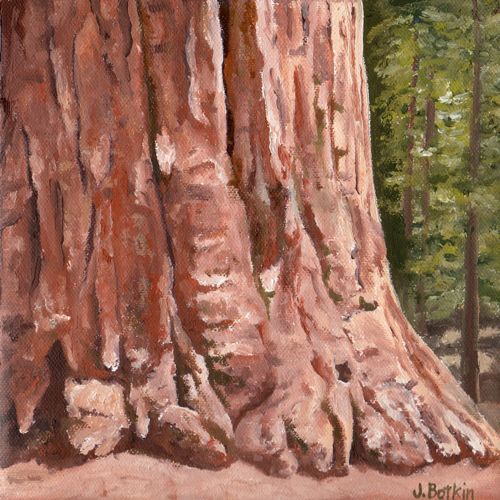When non-profits want to raise funds, they hold dinners or tastings and have silent and live auctions to go with these events (called “Annual Beg-athons” by author Matt Gleason in the Huffington Post on 6/8/11). The first people they contact to donate items to their causes are artists.
Why artists? Why not dentists, lawyers, gas stations, pharmacists??
There was a year that I donated more than I sold. (Hmmm, someone might possibly benefit from a business manager here. . .) That year I decided to stop the insanity. I began reading what other artists had to say about the matter.
Sequoia oil painting, 8×8″, sold? Nope, donated.
There are many reasons for artists to not donate and a few for them to continue donating.
REASONS TO NOT DONATE:
1. An artist is only allowed to write off the cost of the materials.
2. Donating depletes hard-won inventory.
3. Art work at these events usually sells for less than its full value.
4. If an artist develops a reputation for giving away work, those who paid full price will feel ripped off.
5. If an artist develops a reputation for giving away work, the buying public may begin waiting for the events instead of spending money with the artist.
6. If an artist gets tired of donating, she may begin donating second-rate work and damage her reputation. An artist friend once told me, “Just give them your bad stuff that won’t sell anyway.” Yikes, is that what is happening?? That’s not good for the organization, the artist’s reputation or the recipient!
REASONS TO DONATE (and some are pretty poor reasons):
1. An artist loves the cause and want to help.
2. An artist wants to reduce inventory.
3. An artist wants exposure (which is a myth in terms of building a business.)
4. An artist feels guilty and wants to “give back”. (What did he take in the first place??)
If you are part of a non-profit, you might rethink this common idea that artists are the best ones to approach for donations.
Here is an idea for non-profits: Ask to buy the work. The artist can sell it to you at a discount, you can write off what your organization spends, and you can begin the bidding at that price. Anything you receive above that will be profit for you, and none of the Reasons To Not Donate will happen.
A few weeks ago I got caught up in the spirit of an event and spent a very long day helping to create labels for the silent auction. It was a fun day, and I ended up donating a painting. A good friend bought it, and I’m very happy for all the parties involved. I donated the painting because of Reason To Donate #1, which I think is the only good one on the list.
Meanwhile, here is a letter I’ve borrowed from New York Times writer Tim Kreider on the subject:
“Thanks very much for your compliments on my art. I’m flattered by your invitation to donate a painting or drawing or print or package of cards or to paint a mural. But art is work, it takes time, it’s how I make my living, and I can’t afford to do it for free. I’m sorry to decline, but thanks again, sincerely, for your kind words about my work.”

2 Comments
Great post Jana. Years past I was caught up in this assumption that artists can and should donate their artwork easily to non-profit organizations. Part of their line was you can deduct it as an expense. To my ignorance at the time, I had no idea it was only the cost of the materials that are deductible. Many non-profits do not know that either. Artists must rise up to help inform these groups, and not feel guilty doing so, nor feel guilty if they decline to participate.
After exploring this issue a year ago, I learned some valuable tips on how to respond when approached for donations. That led to developing a document I give to those who inquire about donating.
Here is part of my introduction (perhaps it will be of help to other artists)
“Due to the complexities of requests for artwork donations from charities, I’ve developed guidelines that enable me to donate artwork at less than retail cost and allow the artist, the charity, and the purchaser to benefit. These guidelines take into consideration that current U.S. tax laws are unfavorable to artist donations. (Presently write-off of artists’ donations is only for costs of materials in the artwork!)
Please consider that by offering these terms for all artist donations your organization will attract top quality artwork. In addition, over time your charity will become known to artists and art patrons as the go-to-organization for unique and valuable art while supporting your worthy cause.”
This is a great topic. I hope it generates much discussion and benefit for all parties concerned!
Nancy, you have been a great help and source of information to me as I have been learning more about how to handle the incessant requests. I have revised and used your document, but so far I just get, “THERE’S NO WAY OUR ORGANIZATION COULD DO THAT!!” Thanks to your encouragement, I am not giving up. And thank you for stopping by and commenting – I feel honored to have you visit my site.
Comments are closed for this article!